10 Downing Street - a Brief History
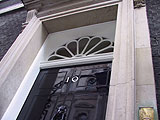
10 Downing Street is a historic building that is also a place of work for hundreds of people.
Behind the black front door lies a series of elegant state rooms, used both for official receptions and everyday meetings. Offices for the staff of the Prime Minister are crammed into every spare space.
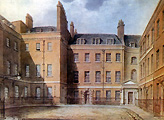
History of the building
Behind the quiet facade of this famous black door lie many secrets.
Number 10 has been the setting for violent riots, passionate protest and surprising activities.
It has been the nerve centre of the British Government through two World Wars.
Pioneering policies have been developed inside its walls and world-changing meetings have been chaired by Britain's greatest leaders.
It is used as a busy office and workplace for the Prime Minister and the staff employed to support him in his role.
Not least it is also home to the PM and his family.
Downing Street began its association with the office of the Prime Minister in 1730.
That the house is still being used today by Tony Blair is down to the refusal of first-ever PM Robert Walpole to accept the house as a personal gift. Instead he insisted it be used by future "First Lords of the Treasury".
During its history the house has undergone major development to be turned into a grand residence fit for the most powerful politician in the country.
Read on to uncover more of its secrets...
Bogs, Brewing and Banqueting
The site where Downing Street now stands rose to importance early in British history.
Settlement by the Romans, Anglo Saxons and Normans made the area around today's Westminster a prestigious centre of government over 1000 years ago.
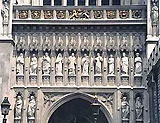
Location, location, location
Thorney Island - 'the island of thorns' - was a marshy piece of land lying between two branches of the river Tyburn that flowed from Hampstead Heath down to the Thames.
The land was boggy, creating problems for building which persist today, but it did have an ideal position. A ford across the river Thames joined the Roman road from Kent near where Westminster Bridge now stands, creating good transportation links.
For that reason, the Romans chose Thorney Island as a good place to settle, and the area began to develop. Traces of these Roman and later Saxon buildings have been found within the grounds of Number 10.
The early settlements were not very successful. The area was prone to plague and its inhabitants were very poor. A document of the Mercian King Offa in 785 refers to "the terrible place which is called Thorney Island".
It took royal patronage to give the area prestige. King Canute (reigned 1017-35) built a palace in the area, and Edward the Confessor (reigned 1042-66) and William I (reigned 1066-87) followed suit.
Westminster, as the area became known, quickly became the centre of government and Church, with the building of the great abbey nearby.
The earliest building known to have stood on the site of Downing Street was the Axe brewery owned by the Abbey of Abingdon in the Middle Ages. But by the early 1500s, the brewery had fallen into disuse.
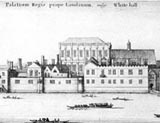
Henry VIII's pleasure palace
Henry VIII (r. 1509-47) made Westminster even more important by building an extravagant royal residence there.
Whitehall Palace was created when Henry VIII confiscated York House from Cardinal Wolsey in 1530 and extended the complex. Today's Downing Street is located on the edge of the Palace site.
The huge residence included tennis courts, a tiltyard for jousting, a bowling green and a cockpit for bird fights. Stretching from St. James's Park to the Thames, it was the official residence of Tudor and Stuart monarchs until it was destroyed by fire in 1698.
It made the surrounding real estate some of the most important and valuable in London - and the natural home of power.
The First Houses on Downing Street
Even before the role of prime minister existed, the inhabitants of today's Downing Street were keenly involved in politics. Early residents were at the centre of momentous historical events.
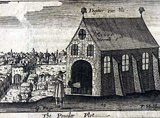
Knyvet House
The first domestic house known to have been built on the site of Number 10 was a large building leased to Sir Thomas Knyvet. A Member of Parliament for Thetford and Justice of the Peace for Westminster, his claim to fame was arresting Guy Fawkes for his part in the Gunpowder Plot of 1605.
The house was first leased to him in 1581 by Queen Elizabeth I. One of the Queen's favourites, he held high rank in her court. He was a Gentleman of the Privy Chamber and in 1581 became the Queen's Keeper of the Palace.
Royal patronage continued under James I, who knighted Knyvet in 1604. His lifetime lease on the house was extended in 1604 so that Sir Thomas' heirs would hold the property for sixty years after his death. Now named 'Knyvet House', the building was made of timber and brick and had a large L-shaped garden.
After the deaths of Knyvet and his wife in 1622, the house passed to their niece, Elizabeth Hampden, who lived there for the next 40 years.
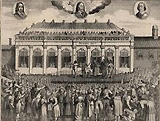
Revolution and restoration
The middle of the seventeenth century was a period of political upheaval, and Mrs Hampden's family was right in the middle of it.
Her son, John Hampden, a Member of Parliament, was one of the leaders of Parliamentary opposition to King Charles I. Oliver Cromwell, the Lord Protector, was her nephew.
The house, known as 'Hampden House', gave Elizabeth Hampden a prime view of the tumultuous events of the Civil War, Commonwealth and the early years of the Restoration.
Charles I's execution in 1649 took place on a scaffold in front of Banqueting House in Whitehall, within earshot of the house. She was still living in the house when King Charles II (r. 1649-85) was restored to the throne in 1660.
'Tymber and Flemish galle'
One of the earliest descriptions of the house on today's Downing Street survives from the seventeenth century. The Parliamentary Commissioners, who took over Crown lands during the Commonwealth, described the house in 1650:
-
"....built part wth Bricke and part wth Tymber and Flemish qalle and covered with Tyle, consistinge of a Large and spacious hall, wainscoted round, well Lighted, and Paved wth brick Pavements, two parls whereof one is Wainscoted round from the seelinge to ye floor, one Buttery, one seller, one Large kitchen well paved with stone and well fitted and Joynted and well fitted wth dreser boards....
"And above stayres in the first story one large and spacious dyneinge Roome, Wainscoted round from the seelinge to the floore, well flored, Lighted and seeled, and fitted wth a faire Chimney wth a foote pace of Paynted Tyle in the same. Also 6 more Roomes and 3 Closetts in the same flore all well lighted and seeled. And in the second story 4 garretts...."
George Downing and his Street
Downing Street was built as a result of one man's scheming.
Sir George Downing was an enterprising rogue - a spy, traitor and shady property developer - who saw building houses on prime London land as a means to get rich quick.
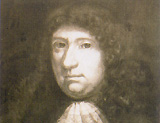
'A perfidious rogue'
Brought up in New England, Downing was one of the earliest graduates of Harvard University. He came back to England during the Civil War, and by 1650 he was Cromwell's Scoutmaster General or intelligence chief. At the heart of Cromwell's inner circle, he enjoyed a position of great power.
In 1657 Downing was appointed British Ambassador to The Hague, where he worked against the exiled royal family. But when Cromwell died in 1658, his son Richard, who turned out to be an incompetent leader, replaced him.
Downing realised that the fortunes of the Commonwealth were about to take a turn for the worse, and set about ensuring his position under a new regime.
His method was to betray his former allies completely. He presented himself to Charles II and offered his services to the Crown. Diarist Samuel Pepys described him "a perfidious rogue".
Luckily for Downing, the King recognised the value of the information he could provide. Downing did spend two months in the Tower after an ill-fated return to Holland, but went on to accumulate honours and rewards after the Restoration.
Downing the developer
Downing set about making his fortune. Getting hold of the land around Hampden House was one of his main aims. He saw early on that it was ripe for development, given its location near Westminster, and set about gaining the right to build there.
In 1654 Downing acquired the Crown interest in the land, but he could not take possession as it was under lease to Knyvet's descendents. It was not until 1682, nearly 30 years later, that Downing finally secured the leases to the property.
He quickly set about the project, pulling down existing properties. In their place sprang up a cul-de-sac of 15 or 20 terraced houses along the northern side of Downing Street.
Designed for a quick turnover, Downing's houses were cheaply built, with poor foundations for the boggy ground. Instead of neat brick facades, they had mortar lines drawn on to look like even-spaced bricks.
The original numbering of the houses was completely different to today's. The number sequence was haphazard, and the houses tended to be known by the name or title of their occupants. The current Number 10 started out life as Number 5, and was not renumbered until 1779.
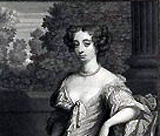
'The House-at-the-Back'
Downing's house is only half the story. The present Number 10 is made up of two houses joined together: Downing's cheap terrace house at the front, and a much grander building, overlooking Horse Guards Parade.
The house on Horse Guards was built around 1677. It became the home of the Countess of Lichfield, daughter of Charles II. As befitted her station, it was much more impressive than the terrace behind.
The Countess was very annoyed at the new houses being built so close. She complained to her father, who wrote back with advice: "I think that it is a very reasonable thing that other houses should not look into your house without your permission, and this note will be sufficient for Mr Surveyor to build up your wall as high as you please."
The surveyor in question was Sir Christopher Wren, the architect responsible for St. Paul's Cathedral and some of Britain's greatest buildings.
After the Lichfields left in 1690, the house passed to Lord Overkirk - William III's Master of the Horse. Then in 1720, after the deaths of Lord Overkirk and his wife, 'Overkirk House' was renamed 'Bothmar House' after its new resident, Count Bothmar.
Count Bothmor died in 1732. The last private resident of Downing's terrace was one Mr Chicken. Little is known about him except that he moved out in the early 1730's.
At that point, the terrace on Downing Street and the house on Horse Guards began their association with the office of prime minister.
The Prime Minister Moves In, 1730-42
In the 1730s Number 10 began to be linked to the office of prime minister.
It was a period of great change. Rule by a powerful monarch had given way only a few decades earlier to a different style of government led by Parliament and party politics. It became important to house the chief ministers in buildings grand enough for their status.
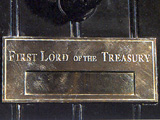
First Lord of the Treasury
King George II presented both the house on Downing Street, and the house overlooking Horse Guards, to Sir Robert Walpole, who held the title First Lord of the Treasury and effectively served as the first prime minister.
Walpole refused the property in Downing Street as a personal gift. Instead he asked the King to make it available to him, and future First Lords of the Treasury, in their official capacity.
To this day prime ministers occupy Number 10 in the role of First Lord of the Treasury. The brass letter box on the black front door is still engraved with this title.
Walpole took up residence in 1735, but only after having the two houses - the one on Downing Street and the one overlooking Horse Guards - joined together and completely refurbished to match his status.
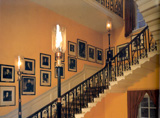
Changing rooms
Walpole employed famous architect William Kent to take on the project. Kent was a Palladian architect who created grand, classical designs inspired by Roman buildings, a style of architecture popular in the eighteenth century.
Walpole had already employed Kent to improve Houghton House, his home in Norfolk. While working on Walpole's commission, Kent also designed another larger building just along the road. This was the new Treasury building, part of which is home to the Cabinet Office today.
Kent carried out extensive work on the two houses in Downing Street. He connected them up on two storeys, so that the main entrance faced onto Downing Street rather than towards Horse Guards.
He made little alteration to the Downing Street building, which now became a passageway from the rear of the house to the street outside.
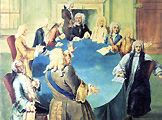 At the back of the house, where the Walpoles lived, Kent created grand new rooms suitable for receiving important guests, and built an unusual, three-sided staircase. It is still one of the most impressive features of the building.
At the back of the house, where the Walpoles lived, Kent created grand new rooms suitable for receiving important guests, and built an unusual, three-sided staircase. It is still one of the most impressive features of the building.
Walpole used the ground floor for business, taking the largest room, on the north-west side of the house, as his study. It is now the Cabinet Room.
Upstairs on the first floor, the Walpoles lived in the rooms facing onto Horse Guards Parade. Lady Walpole used today's White Drawing Room as her sitting room, and the present-day Terracotta Room served as the Walpoles' dining room.

High society
The Walpoles were soon entertaining important guests in their smart house, from Queen Caroline, the wife of George II, to politicians, writers and soldiers.
There was more than a hint of scandal too. Estranged from his wife, Walpole openly entertained his mistress Maria Skerett in the house, followed by a string of other lady friends after his wife's death.
Walpole resigned in February 1742 and left Downing Street that summer. It was some years before the next First Lord moved in.
Riots and Reform, 1742-1806
After Walpole left in 1742, it was over 20 years before another First Lord of the Treasury moved in.
Walpole's successors saw the house as a perk of the job, which they could hand over to fellow politicians, family and friends. And prime ministers Henry Pelham (1743-54) and the Duke of Newcastle (1754-56 and 1757-62) preferred to live in their own residences.
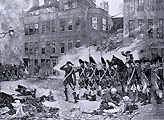
A house under siege
It wasn't until 1763 that the next prime minister took up residence. George Grenville was there for only two years, as he was sacked by George III in 1765 for imposing stamp duty on the American colonies.
The next prime minister to move in was Lord North, who became First Lord in 1770. A home-loving figure, he became very fond of the house and often entertained there.
Visitors included writer Samuel Johnson and Thomas Hansard, founder of the Parliamentary reporting system that still exists today. Clive of India was such a popular guest that furniture was made especially for him; it still exists in the first-floor Ante Room and Terracotta Room.
During one memorable dinner party held by North uproar broke out in the street outside. On 7 June 1780 disgruntled Protestants unhappy with North's policy towards Roman Catholics rioted all over London in an event known as the Gordon Riots. Grenadier guards faced a large mob of protestors in Downing Street.
It might have ended in bloodshed, as it did elsewhere in the city, but North went outside to warn the protestors of the dangers of being shot, and the crowd went away. North's dinner guests climbed to the top of the house to watch the fires all over London.

Home improvements
During Lord North's time, more improvements were made to the house. In 1766 a major series of repairs began, which dragged on for nearly eight years.
Some of the house's most distinctive features were added around this time - the black and white chequerboard floor in the entrance hall, the lamp above the door and the famous lion's head door knocker.
Towards the end of Lord North's occupation, work began again under architect Sir Robert Taylor on further repairs and the addition of a new vaulted kitchen next to Treasury Green.
Lord North resigned as prime minister in 1782, following the loss of the American colonies. The Duke of Portland, prime minister for only nine months, lived in the house briefly, before 24-year-old William Pitt the Younger moved in.
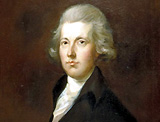
Socialising and surgery
Britain's youngest ever prime minister, Pitt was resident at Number 10 1783-1801 and 1804-1806, and made it more his home than any one else.
The house was a hive of political activity. Pitt planned some of his greatest projects in his office there, including Parliamentary reform, free trade and the improvement of national finances.
It was also a social hub. A keen entertainer and port drinker, Pitt invited guests including William Wilberforce, who was working on the abolition of slavery, and George Canning, a future foreign secretary and prime minister.
One of the stranger events in Number 10's history occurred in September 1786, when William Pitt underwent an operation in the house for the removal of a facial cyst - without anaesthetic. Once the operation was over, he reportedly told the surgeon off for taking 30 seconds longer than promised.
Building work continued during Pitt's occupation. Soon after moving in, Pitt had to justify the ?20,000 cost of recent work on the house to Parliament, which caused much grumbling in the press.
The biggest change during his occupation was the creation in 1796 of the Cabinet Room as it exists today. The room was extended by knocking a wall down and inserting columns to carry the extra span.
Pitt died in 1806, aged only 46. Living in Downing Street for over 20 years, he remains the longest tenant in Number 10's history.
Death and Decay in Downing Street, 1807-76
In the nineteenth century, Downing Street fell on hard times.
Number 10 continued to serve as the prime minister's office, but it fell badly out of favour as a home following a series of unfortunate events.
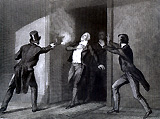
Death by assassin's hand
The early nineteenth century saw one of the most shocking events in the house's history. Lord Grenville's successor, Spencer Perceval, came to Number 10 in a carriage and left in a coffin.
A high-flying lawyer, politician and family man, he arrived at Number 10 in 1807 as Chancellor of the Exchequer, and became prime minister two years later. His twelve young children - some born while he was prime minister - filled every spare room of the house.
It made the events of 11 May 1812 especially tragic. Entering the lobby of the House of Commons in the late afternoon, Perceval was shot in the chest by a former convict with a grudge. His body was taken back to Number 10, where it lay for five days before the funeral.
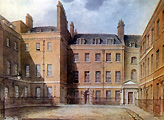
Murder by mistake
After Perceval, the next prime minister to occupy Number 10 was Viscount Goderich (1827-28). He employed the brilliant, quirky architect John Soane to make the house more suitable for its high-profile role. Soane created the wood-panelled State Dining Room and the Small Dining Room for elegant entertaining.
By the 1820s Downing Street emerged as the centre of the Government, with Number 11 becoming the Chancellor of the Exchequer's official residence in 1828.
But the area around the street was becoming more and more seedy, with brothels and gin parlours multiplying. Things got so bad that by 1839 there were even plans to demolish Number 10 and the other buildings on the north side of Downing Street to make way for a remodelled Whitehall.
Security also became an issue. In 1842 Edward Drummond, the secretary of Prime Minister Robert Peel, was murdered in Whitehall on his way back to his home in Downing Street by a half-crazed assassin who mistook him for Peel.
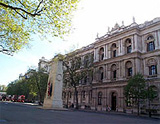
Decline of Downing Street
For 50 years, few prime ministers chose to live in Downing Street, preferring their own townhouses instead. Lord Wellington (1828-30) moved in only while his own lavish home - Apsley House - was being refurbished.
Later leaders such as Lord Melbourne (1834 and 1835-1841) and Viscount Palmerston (1855-58 and 1859-65) used Number 10 only as an office and for Cabinet meetings.
The prestige of Downing Street was reduced even further by the building of the magnificent new Foreign Office building at the end of the 1860s. George Gilbert Scott's creation, with a huge open court and elaborate state rooms, dwarfed Number 10 opposite. It even had its own Cabinet Room in which the Cabinet sometimes met, rather than at Number 10.
By the time Benjamin Disraeli became prime minister for the first time, the house was in poor shape. Having moved his office into the house in 1868 by necessity, Disraeli described it as "dingy and decaying". It was time for modernisation.
Doing up Downing Street, 1877-1937
The late nineteenth and early twentieth centuries saw 10 Downing Street transformed from a humble terraced house into a grand residence with modern facilities - a home and office fit for the most powerful politician in the country.
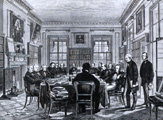
What the butler saw
When Benjamin Disraeli went to live at Number 10 in 1877, the house was in poor shape. The living quarters had not been used for 30 years.
Disraeli persuaded the state to pay for renovation to the entrance halls and public rooms, though he paid himself for the private rooms to be refurbished. His own first-floor bedroom and dressing room were improved, and a 'bath with hot and cold water in the First Lord's Dressing Room' was put in for ?150.3s.6d..
When Gladstone moved into the house for the first time in 1880, he insisted on redecorating after Disraeli's occupancy, spending ?1,555.5s.0d., an enormous sum for the time, on furniture. In 1894, during his last occupancy as prime minister, electric lighting was fitted and the first telephones were installed around the same time.
Gladstone was renowned for eccentric behaviour during his occupation of Number 10. Famous for his interest in converting prostitutes, Gladstone would bring young women back to Downing Street to talk to them. Members of the Cabinet would sometimes pass women in the hallway as the butler was showing them out.
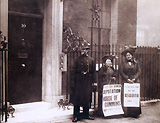
The most famous front door in the world
The Marquess of Salisbury, who followed Gladstone, was the last prime minister not to live at Number 10. Salisbury never liked the Cabinet Room, describing it as a 'cramped close room'.
He preferred to work in the larger Cabinet Room in the Foreign Office and live in Arlington Street, offering Number 10 to his nephew, Arthur Balfour (1902-05), who also later became prime minister. Balfour was the first inhabitant of Number 10 to bring a motor car to Downing Street.
From Balfour onwards, Number 10 became the residence and office for all British prime ministers. It became the focus for protest, petition and gatherings at times of national crisis. Pictures of people coming and going in front of the black front door went around the world.
One of the most famous photographs was captured in January 1908, during Asquith's premiership. Suffragettes won national attention for their campaign for women's votes by chaining themselves to the railings outside Number 10. Policemen with hacksaws had to be called to remove them.
Six years later, with the outbreak of the First World War, the Cabinet Room at Number 10 was the nerve-centre of Britain's war effort. Under Prime Minister David Lloyd George, the number of staff at Number 10 expanded and offices spilled out into the garden to cope with the war.
When armistice was finally declared on 11 November 1918, crowds thronged Downing Street chanting 'LG'. Lloyd George made an appearance at one of the first-floor windows to acknowledge them.
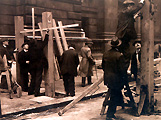
Barricades and book shelves
Even when the war was over, security remained essential. As the movement for Irish independence became increasingly violent, three-metre-high wooden barricades were erected for the first time at the end of the street, preventing protestors attacking the prime minister.
The barriers were taken down in 1922 with the creation of the Irish Free State, but returned in 1989 in the form of high metal gates.
Other important changes took place to the house. Labour Prime Minister Ramsay MacDonald wanted Number 10 to regain some of the grandeur it had during the times of Walpole and Pitt.
Missing a proper library containing more than Hansard reports, MacDonald started the Prime Minister's Library, which was housed originally in the Cabinet Room. The custom began of the prime minister and other ministers donating books to the library; it continues today.
Central heating was installed in 1937 and work began on converting the labyrinth of rooms in the attic, which had formerly been used by servants, into a flat for the prime minister.
Number 10 at War
As tension mounted in Europe in the 1930s, Number 10 became the focus of international attention.
In 1938 Prime Minister Neville Chamberlain posed outside the front door bearing the famous 'Peace in our Time' document which declared that any future disputes between Britain and Germany would be settled peacefully.
Almost exactly one year later, on 3 September 1939, Chamberlain broadcast from the Cabinet Room, announcing that the country was now at war with Germany.
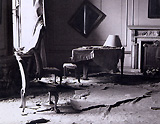
Defending Downing Street
When Winston Churchill replaced Chamberlain as Prime Minister, he and his wife moved into Downing Street's second-floor flat, where Churchill did much of his work.
He often dictated speeches, memos and letters to his secretary while lying propped up in bed in the morning or late in the evening, cigar in hand.
By October 1940, the intense bombing period known as the Blitz began. On 14 October, a huge bomb fell on Treasury Green near Downing Street, damaging the Number 10 kitchen and state rooms and killing three civil servants doing Home Guard duty.
Churchill was dining in the Garden Rooms when the air raid began. He recalled:
-
- We were dining in the garden-room of Number 10 when the usual night raid began. The steel shutters had been closed. Several loud explosions occurred around us at no great distance, and presently a bomb fell, perhaps a hundred yards away, on the Horse Guards Parade, making a great deal of noise.
- Suddenly I had a provincial impulse. The kitchen in Number 10 Downing Street is lofty and spacious, and looks out through a large plate-glass window about 25 feet high. The butler and parlourmaid continued to serve the dinner with complete detachment, but I became acutely aware of this big window. I got up abruptly, went into the kitchen, told the butler to put the dinner on the hot plate in the dining-room, and ordered the cook and the other servants into the shelter, such as it was.
- I had been seated again at the table only about three minutes when a really loud crash, close at hand, and a violent shock showed that the house had been struck. My detective came into the room and said much damage had been done. The kitchen, the pantry and the offices on the Treasury were shattered.
(Their Finest Hour, 1949)
Steel reinforcement was added to the Garden Rooms and heavy metal shutters were fixed over windows as protection from bombing raids. The Garden Rooms provided a small dining room, bedroom and a meeting area which were used by Churchill throughout the war. In reality, though, the steel reinforcement would not have protected him against a direct hit.
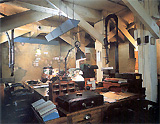
Downing Street in dust sheets
In October 1939 the Cabinet had moved out of Number 10 and into secret underground war rooms built in the basement of the Office of Works opposite the Foreign Office.
Following near-misses by bombs, in 1940 Churchill and his wife moved out of Downing Street and into the Number 10 Annex above the war rooms. Furniture and valuables were removed from Number 10; only the Garden Rooms, Cabinet Room and Private Secretaries' office remained in use.
But Churchill disliked living in the Annex. Despite its being almost empty, Churchill continued to use Number 10 Downing Street for working and eating.
A reinforced shelter was constructed under the house for up to six people, for use by those working in the house. Even George VI sought shelter there when he dined with Churchill in the Garden Rooms.
Although bombs caused further damage to Number 10, there were no direct hits to the house, allowing Churchill to continue to work and dine there right up until the end of the war.
Victory
As soon as war was over, Churchill and his wife moved back to Number 10. And it was the triumphant setting for his VE Day broadcast, delivered from the Cabinet Room at 3pm on 8 May 1945.
1945 to the present
After the damage of the Second World War, drastic action was required to make Number 10 fit for prime ministers again, and to bring it up to date with modern technology.
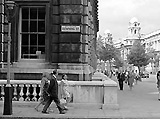
Number 10 is falling down
From 1945 to 1950, war damage in the house was repaired. The attic was converted into a flat, and Prime Minister Clement Attlee and his wife moved into it instead of the first-floor rooms where earlier prime ministers had lived. The flat included a sitting room, dining room, a study, and a number of bedrooms.
By the 1950s the state of the fabric of 10 Downing Street had reached crisis point. Bomb damage had made existing structural problems worse - the building was suffering from subsidence, sloping walls, twisting door frames and an enormous annual repair bill.
The Ministry of Works carried out a survey in 1954 into the state of the structure. The report bounced from Winston Churchill to Anthony Eden to Harold Macmillan as one followed the other. Finally, a committee set up by Macmillan concluded that drastic action was required before the building fell or burnt down.
They put forward a range of options, including the complete demolition of Number 10, 11 and 12 and their replacement with a new building. That idea was rejected and instead it was decided that Number 12 should be rebuilt; Number 10 and 11 should be strengthened and their historic features preserved.
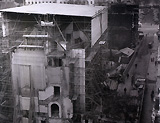
Gutting the house
The architect Raymond Erith was selected to supervise the work. The work was expected to take two years and cost ?500,000. It ended up taking a year longer than planned, and costing double the original estimate. The foundations proved to be so rotten that concrete underpinning was required on a massive scale.
Number 10 was completely gutted. Walls, floors and even the columns in the Cabinet Room and Pillared Room proved to be rotten and had to be replaced. New features were added too, including a room facing onto Downing Street and a verandah at Number 11 for the Chancellor.
It was also discovered that the familiar exterior facade was not black at all but yellow. The blackened colour was a product of two centuries of severe pollution. To keep the familiar appearance, the newly cleaned yellow bricks were painted black to match their previous colour.
Erith's work was completed in 1963, but not long afterwards dry rot became apparent and further repairs had to be undertaken.
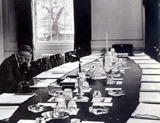
Personal PM touches
As prime ministers came and went over the following decades, they all left their mark on Number 10.
Harold Macmillan replaced the rectangular Cabinet Room table with a curved one, which enabled the Prime Minister to see everyone around the table without anyone leaning forward.
In the 1970s, Edward Heath redecorated and added furniture to the state rooms, which changed from being the day-to-day living space of the prime minister to rooms set aside for official business.
He adored Number 10 and used it not only as his office and town house, but also as a showcase for music, painting and sculpture. He installed his own grand piano in the White Drawing Room.
Margaret Thatcher appointed architect Quinlan Terry to refurbish the state drawing rooms at the end of the 1980s. Two of the rooms, the White Drawing Room and Terracotta Room gained ornate plasterwork ceilings. In the White Drawing Room this included adding the national emblems of England, Northern Ireland, Scotland and Wales.
Shell shock
All the building work of the past few decades could have been ruined when a terrorist bomb exploded in 1991. An IRA mortar bomb was fired from a white transit van in Whitehall and exploded in the garden of Number 10, only a few metres away from where John Major was chairing a Cabinet meeting to discuss the imminent Gulf War.
Although no one was killed, it left a crater in the Number 10 gardens and blew in the windows of neighbouring houses. John Major and some of his staff moved into Admiralty Arch while damage caused by the bomb was repaired.
Other renovations in the 1990s included replastering the Cabinet Room ceiling, which seemed to be in danger of falling in, and the installation of vast amounts of IT cabling and other modern technology to ensure that the prime minister would be fully up to date with events as they happened.
Downing Street Today
Number 10 Downing Street has never been busier than it is today. It is an office for the prime minister, a meeting place for the Cabinet, a venue for state events and a home for the prime minister's family.
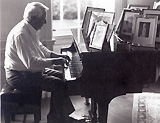
'Living above the shop'
While in office, prime ministers traditionally live with their families in Downing Street in the private flat on the second floor. Prime Minister Tony Blair lives in the larger flat above Numbers 11 and 12, which has more room for his family.
'Living above the shop', as Margaret Thatcher described it, has sometimes made it difficult for prime ministers to separate family life and work, but it does allow him or her to keep fully in touch with events as they develop.
Fortunately, prime ministers no longer have to furnish the whole house themselves. Until the twentieth century, prime ministers who lived in Downing Street used to bring their own households with them - bedding, crockery and furniture. They would arrange their possessions in the state rooms on arrival and move them out when they left office.
Prime ministers today have an opportunity to select the art that hangs on the walls of Number 10. In the eighteenth and nineteenth centuries prime ministers brought their own paintings to display in the house.
Ramsay MacDonald was the first prime minister not to have a personal art collection and began the convention of borrowing from national collections to make the prime minister's residence into a showcase for traditional and modern British art and craftsmanship.
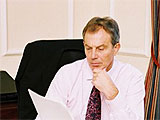
Number 10 as Office
Number 10 is a busy office and workplace for the prime minister and the staff employed to support him.
The prime minister has his own room where he works and reads. There, or in other rooms in the house, he may meet colleagues, receive important guests, make phone calls or give interviews.
Number 10 is also the venue for the regular Cabinet meeting. The Cabinet meets every Thursday while Parliament is in session in the Cabinet Room, which has used by successive Cabinets since 1856.
The house is also a workplace for the people who support the prime minister, mostly civil servants. The staff includes the secretaries of the basement Garden Room, a busy press office, switchboard clerks and a unit to handle correspondence.
As Number 10 was built as a private house, the offices are spread across many rooms on different floors.
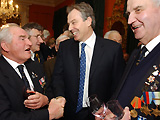
Entertaining at Number 10
Nearly every week Number 10 is the venue for official functions including meetings, receptions, lunches and dinners.
It isn't only heads of state and official dignitaries who visit - functions are held for people from all areas of UK society, including notable achievers, public service employees and charity workers.
Receptions tend to be informal gatherings. Drinks and canapes are served, as guests wander through the historic state rooms enjoying the art and historic objects on display. The prime minister and other hosts circulate to meet as many people as possible.
Lunches and dinners are more formal events. The Small Dining Room will sit a maximum of 12, and the State Dining Room up to 65 around a large, U-shaped table.
The dining table is laid with items from the state silver collection - a range of modern silverware pieces commissioned by the Silver Trust to promote modern British craftsmanship.
Before the Government Hospitality Fund was set up in 1908, prime ministers employed their own servants for entertaining at Number 10.
Nowadays members of the Fund work together with the prime minister's social team to arrange functions, checking guest lists, printing invitation cards and menus, working out the seating plans, and plan the meal.
All the attention to detail ensures that guests enjoy a memorable visit to a remarkable house.